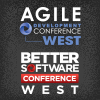Agile Development Conference & Better Software Conference West 2011

PRESENTATIONS
|
Agile Database Development
If you've had difficulty applying agile methods to the database side of development, you're not alone. Most developers see the database as an obstacle to-not a part of-agile development. Pramod Sadalage shows how to apply agile development principles to the database, thereby making the database an integral part of the application development effort. To allow for rapidly changing requirements, Pramod explains how you can make the database and its data more flexible. |
|
|
Agile Development & Better Software West 2011: Agile Testing: Challenges Beyond the Easy Contexts
Don't let anyone tell you differently: Agile testing is hard! First, we have to get over the misconception that you don't need testers within agile teams. Then, we have to integrate testers with the developers and engender a holistic quality approach. And those are only the challenges when the going is easy! In more difficult contexts, testing in agile environments is-well, even more difficult. |

Bob Galen, iContact |
|
Agile Leadership: Where Do Managers Fit?
When adopting agile software development, many of the agile roles and practices focus on the team and its members. So, where does that leave the managers-project managers, software managers, IT directors, etc? Based on his many years as an agile coach, Skip Angel answers these questions and explores the role of leadership in software development. Skip discusses common challenges agile team face and how managers within the organization are needed to address those challenges. |
|
|
Agile Requirements Engineering: When User Stories Are Not Enough
Agile projects commonly capture customer needs via user stories-placeholders for future conversations about those needs. However, when dealing with complex software products-ones with significant existing functionality or when regulations or customers mandate a requirements-driven development process-user stories are not enough. Under such circumstances, traditional requirements engineering practices can be applied at a high level while the team addresses implementation details using a product backlog of user stories. |
|
|
Avoiding Over and Under Design
The question of how much design to do up-front on a project is an engaging one. Too much design often results in overkill, complexity, and wasted work. Too little design results in insufficient system structures that require rework, additional complexity, and wasted effort. How can we know what the right balance is? Alan Shalloway shows how to use the advice from Design Patterns coupled with the attitude of not building what you don't need from Agile. |
|
|
Better Software Conference West 2011: Lean Development Practices for Enterprise Agile
An enterprise agile initiative requires a higher level strategic, portfolio, product, and team perspective. Lean software development integrates all of these perspectives into a cohesive, actionable whole. It does this through a combination of Lean-Science, Lean-Management, Lean-Team methods, and Lean-Learning. Alan Shalloway shows how these four aspects of lean form the basis for enterprise agility at all the levels. Lean-Science focuses on the laws present in all software development. |
|
|
Beyond a Scrum of Scrums: Scaling Up Agile with Kanban
Backlogs, story point planning, sprints, and retrospectives-Scrum describes processes that work well at the team level. But more is needed to integrate multiple scrum teams that must work closely together. Although the traditional response is to hold daily Scrum of Scrum meetings, planning and executing multi-team, multi-sprint efforts require more coordination and defined practices than a Scrum of Scrums offers. Gil Irizarry describes how his organization combined the best of Scrum and Kanban to manage large development efforts. |
|
|
Building Great Teams
What allows some teams to deliver results that far exceed expectations? How do these groups differ from most others? What can group members and leaders do to enable these extraordinary experiences? Geoff Bellman, along with his partner Kathleen Ryan, spent four years diving deeply into self-declared fantastic teams. |
|
|
Building Great Teams
What allows some teams to deliver results that far exceed expectations? How do these groups differ from most others? What can group members and leaders do to enable these extraordinary experiences? Geoff Bellman, along with his partner Kathleen Ryan, spent four years diving deeply into self-declared fantastic teams. |
|
|
Carrot and Sticks: What Incentives Really Work?
It's surprising how little of the research around incentives has made it into regular management practice. Widespread belief is that the debate is first about carrots vs. sticks and then about the kinds of carrots or sticks. Cognitive scientists, however, suggest that carrots result only in temporary compliance. Rewards, like punishment, are ineffective in producing lasting change. Numerous studies show that offering incentives is not only less effective than other strategies but often proves worse than doing nothing at all. |

Linda Rising, Independent Consultant |


